TL;DR: Semiotic Labs joins IOH #147 to provide an overview of the indexer experience for the Timeline Aggregation Protocol (TAP), as well as more updates on what the team is working on.
Opening remarks
Hello everyone, and welcome to the latest edition of Indexer Office Hours! Today is March 5, and we’re here for Episode 147.
Don’t miss the latest episode of the GRTiQ podcast with Chris Were, CEO and co-founder of Verida, a team working on hyper-personalization, where user data is privately and consensually used to create new products and services.
Repo watch
The latest updates to important repositories
Execution Layer Clients
- sfeth/fireeth: New release v2.3.5 :
- This release deprecates the “RPC Cache (for eth_calls)” feature of Substreams. It has been turned off by default and will not be supported in future releases.
- Substreams RPC: add -substreams-rpc-gas-limit flag to allow overriding default of 50M. Arbitrum chains behave better with a value of 0 to avoid intrinsic gas too low (supplied gas 50000000) errors.
- The reader-node-bootstrap-url gained the ability to be bootstrapped from a bash script.
- Avalanche: New release v1.11.2 :
- Removes deprecated IPC API, auth API, and keystore related methods from the platform API.
- Fixed mempool push gossip amplification.
- Arbitrum-nitro New release v2.3.1 :
- This release fixes validators processing EIP-4844 batches and improves EIP-4844 blob-based batch posting performance and reliability. However, we still recommend waiting for more testing before enabling EIP-4844 batch posting on Arbitrum Orbit chains (the current default configuration does not have EIP-4844 batch posting enabled).
Graph Orchestration Tooling
Join us every other Wednesday at 5 PM UTC for Launchpad Office Hours and get the latest updates on running Launchpad.
The next one is on March 13. Bring all your questions!
Blockchains Operator Upgrade Calendar
The Blockchains Operator Upgrade Calendar is your one-stop solution for tracking hard fork updates and scheduled maintenance for various protocols within The Graph ecosystem.
Simplify your upgrade process and never miss a deadline again.
Protocol watch
The latest updates on important changes to the protocol
Forum Governance
Forum Research
Core dev updates:
- Edge & Node’s March/April Update
- The Guild March 2024 Update
- Messari March 2024 Update
- Pinax March 2024 Update
- Semiotic Labs March 2024 Update
- GraphOps Update March 2024
- StreamingFast March 2024 Update
- Geo March 2024 Update
Contracts Repository
- [WIP/Experimental] Horizon Staking changes #956 (draft)
- chore(deps): bump es5-ext from 0.10.62 to 0.10.64 #955 (closed)
- feat: add code linting and formatting packages #953 (merged)
Project watch
Indexer components
- Allow enabling the Cost Model in other networks than mainnet #707
- The Guild is working on enabling this for multi-network mode Indexer Agent and some related refactoring of the indexer management API.
Graph Node
- Declarative state & aggregations in Graph Node #3555
- Coming in the next release, but currently waiting on a PR to introduce new Timestamp scalar type.
- Aggregations docs
- Feature Request: Support indexed argument filtering #2052
- Edge & Node started working on this last week and hope to include this feature in the release after next. Should help with syncing time.
- [Feature] Declarative eth calls #5262
- Edge & Node started working on this last week and hope to include this feature in the release after next. Parallelizing eth_calls should help with syncing time on certain subgraphs.
Open discussion
Dev update
- Alexis from Semiotic Labs provides a progress update on TAP, with a focus on the indexer experience.
- Refer to the Graph Improvement Proposal: GIP-0054: Timeline Aggregation Protocol.
- View the presentation as PDF.
- This update was not an official announcement that TAP is out. The team is still testing. Check Semiotic’s March 2024 Update for more details.
TAP (Timeline Aggregation Protocol) is a new micro payment system for indexers to receive query payments from untrusted gateways.
For an overview of TAP, scan the QR code to watch the recording of core dev call #22 (timestamp 4:47).
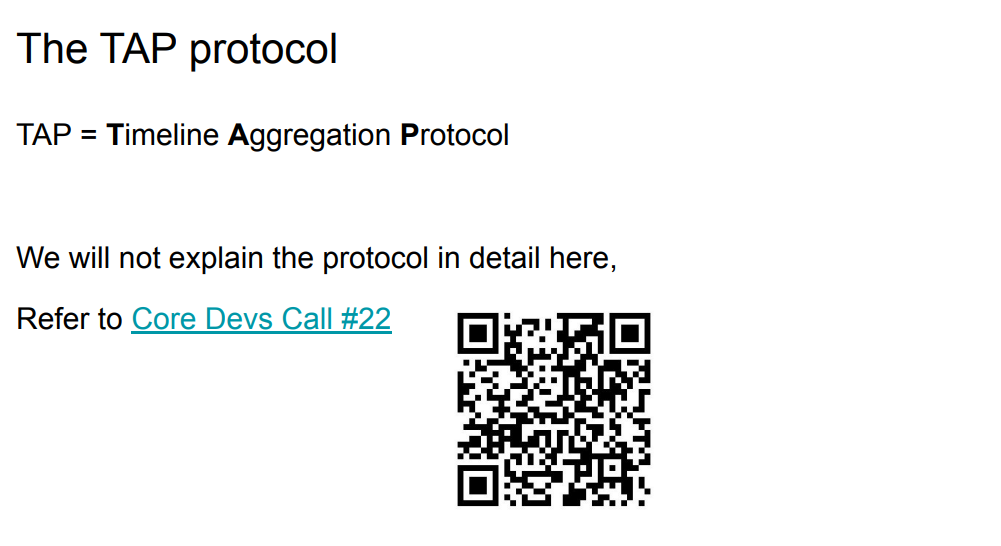
- Alexis covered the user experience for an indexer.
- Unfortunately, you can’t leverage already deployed TAP contracts because they’re hardcoded to send the money to The Graph staking contract, so you would have to redeploy the TAP contracts yourself with your own parameters.
- If a project wants exact accounting, what we call micro trust, and fast, high-bandwidth, unidirectional micropayments, TAP is likely the best answer.
- TAP contracts are deployed only on Arbitrum.
- The amount in escrow depends on how much the consumer is willing to put in.
- TAP is an off-chain solution.
Questions
Q1: Is the escrow contract an on-chain transaction?
Answer: Yes, the escrow contract is a new contract.
Q2: Is the consumer or gateway selecting the indexer and creating the escrow contract?
Answer: There is no rule about how the gateway decides which indexers it will create escrow contracts for; we know that Edge & Node have been working on an automated system to create those escrows.
There isn’t a way to force a consumer to set up escrow contracts with all the indexers.
Q3: What does the RAV look like?
Answer: The best way to understand it is to watch core dev call #22; it has all the details.
More updates from Semiotic
- Seve is working on verifiable data on The Graph; his team is developing a tool to verify flat files against a consensus layer client, enabling indexers to share their flat files trustlessly.
- For example, imagine the flow where you would download the flat files from another indexer and then start your Firehose, link your Geth node in snap sync mode, quickly get up to chain head, and then continue building up on your flat files. Gets your Firehose going much quicker.
- Alexi also discussed a more long-term view of verifiable data on The Graph, using The Graph as a ZK co-processor and trusted oracle.
- On the data services side, the team is working on having an SQL service on The Graph.
- Some big companies are also interested in consuming SQL on The Graph.
- In the future, they want to have a proper SQL service. The plan is for now to have ClickHouse, a fast OLAP database, and the possibility of indexing events directly and dumping everything into a SQL database that people can query and do the equivalent of subgraphs, which would be DBT, materialized view transformations on that event data, so that people can do analytics tables on The Graph.


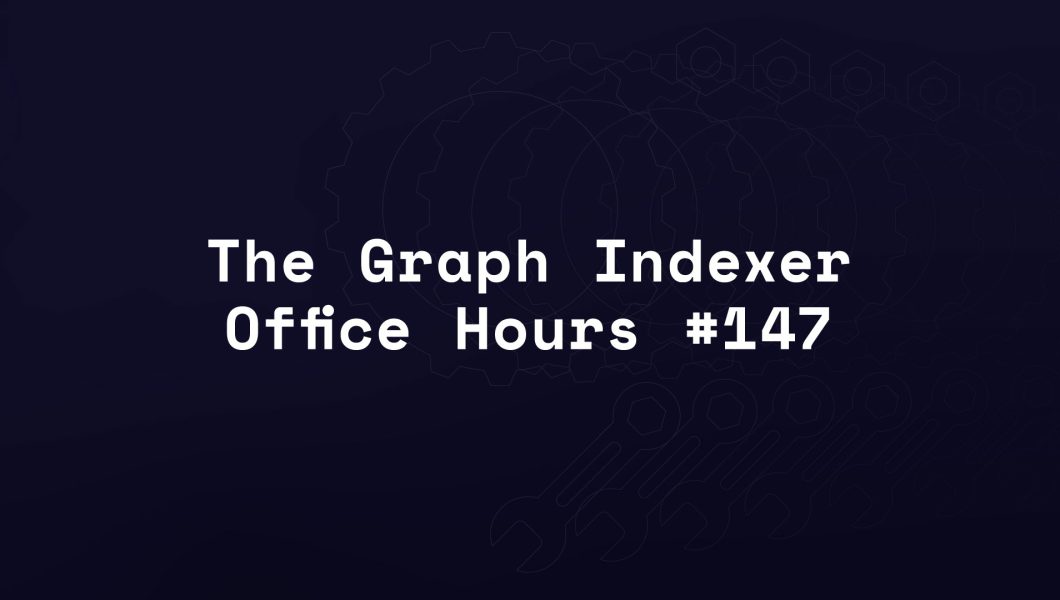

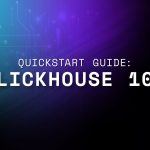
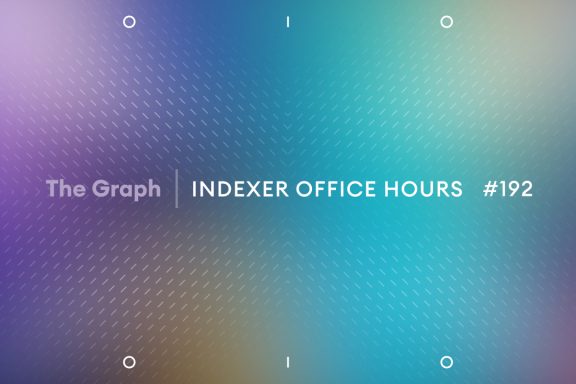
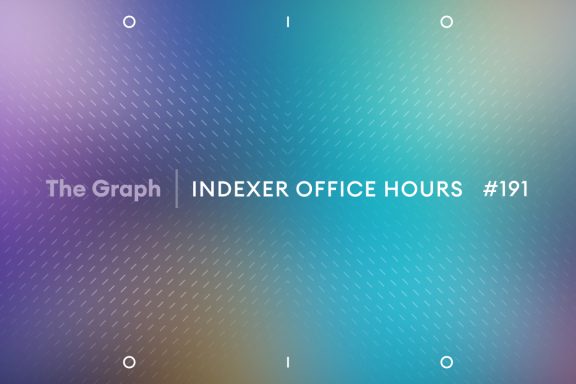
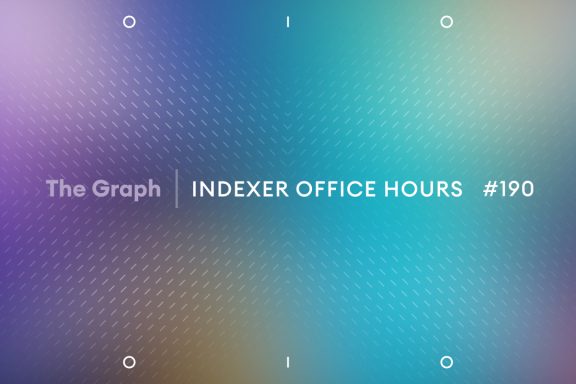
No Comments